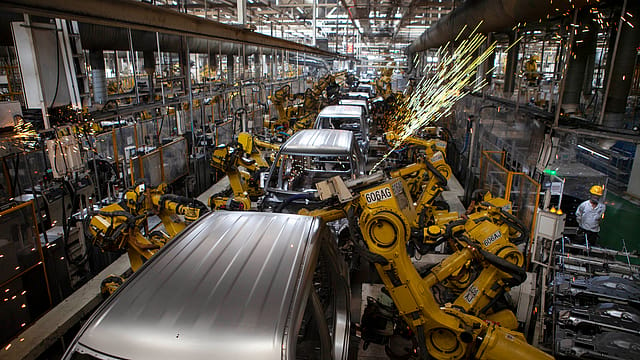Car sales shoot up despite rise in petrol prices
ADVERTISEMENT

After slipping by nearly 10% in January, auto retail sales in February showed signs of recovery and a rebound in demand growth. This recoup in sales comes also in the backdrop of petrol prices crossing ₹100 per litre in many states. Despite that, petrol vehicles have continued to sell. This fact becomes even more interesting when we see that between April and December 2020, the share of petrol cars in the overall passenger vehicle segment had risen close to 83%.
Experts believe that this rise in auto sales is an indication of the economy opening up. In fact, in late February, as per the government's third quarter growth results, the Indian economy emerged from the technical recession of the first two negative growth quarters, clocking a positive gross domestic product (GDP) growth figure of 0.4%, signalling what many economists and the government believe to be the beginning of a V-shaped recovery in FY22.
According to a research report from Bengaluru-based consulting firm RedSeer, mobility in India is also already on the path towards recovery with 63% growth, which translates to 71 million rides overall. This, however, is still lower when compared to what the numbers were during pre-Covid-19 days. During that time, which was roughly around April 2020, India clocked 113 million rides.
December 2025
The annual Fortune 500 India list, the definitive compendium of corporate performance, is out. This year, the cumulative revenue of the Fortune 500 India companies has breached $2 trillion for the first time. Plus, find out which are the Best B-schools in India.
But with nearly all segments showing gradual recovery, reaching pre-pandemic numbers doesn't look too far-fetched.
“Recovery has been faster in metro cities compared to non-metro cities. While Kolkata has witnessed the highest recovery, Mumbai and Delhi are second. As cities return to normalcy, the sector will see a gradual recovery as the main segment that is the working professionals continue remote work,” RedSeer said in the report.
The auto industry has seen a shift towards personal mobility and this is one of the primary reasons why passenger vehicles grew to double digits in February. The other reason, according to experts, is the rising demand for compact cars and utility vehicles.
India's largest carmaker Maruti Suzuki recorded a 9.9% increase in sales from a year-ago period. The company was able to sell 147,483 units during the month as more and more people are now opting for smaller, and more fuel-efficient hatchbacks. Hyundai Motor India's SUVs, too, continued to grow, especially in urban centres. The company's sales grew 29% from a year ago to 51,600 units on the back of strong sales posted by its Venue, Creta, and the i20 hatchback.
It was also a lucky month for Tata Motors as the company said its car sales were the highest ever in at least nine years. It reported a 54% year-on-year increase in total domestic sales. Other automakers like Toyota, Mahindra, and Honda also followed suit and showed double-digit growth in sales.
“The market demand continues to be good which is reflected in our positive growth in February sales. However, the shortage of semiconductor related parts impacted us on the supply front last month, which limited our production volume and dispatches for certain models. In the coming months, we will continue to make production adjustments in order to reduce its impact on our waiting customers,” says Rajesh Goel, senior vice president and director, marketing and sales, Honda Cars India.
The industry feels that growth in demand has brought in much-needed stability in the sector, which is on its way to recovery. That said, it is important to also note that higher sales this year are on the back of a low base in the same period last year. In February 2020, the industry suffered 6.7% decline to 2,50,698 units as compared to 2,68,843 units sold in February 2019. In fact, the auto industry has been reeling under a slowdown for the last three years due to various factors, such as change in emission norms, economic slowdown, rise in insurance costs, increase in vehicle prices, and many more.
The upward trend is not limited to four-wheelers alone. Two-wheeler maker Bajaj Auto's sales went up by 7% while Honda saw a strong growth of 29% to 442,696 units compared to 342,021 units last year.
“While the industry growth is expected to hover near the double digits in Q4 and upcoming Q1 due to the low base of BSVI transition, Honda continues to drive the two-wheeler demand recovery for the second straight month of 2021. We are confident of maintaining the positive sales momentum in coming months too, with our 3 new models (CB350RS, 2021 Africa Twin Adventure Sports, Grazia sports edition) exciting the market,” points out Yadvinder Singh Guleria, director, sales and marketing, Honda Motorcycle & Scooter India.
The industry feels that growth in demand has brought in much-needed stability in the sector, which is on its way to recovery. That said, it is important to also note that higher sales this year are on the back of a low base in the same period last year. In February 2020, the industry suffered 6.7% decline to 2,50,698 units as compared to 2,68,843 units sold in February 2019. In fact, the auto industry has been reeling under a slowdown for the last three years due to various factors, such as change in emission norms, economic slowdown, rise in insurance costs, increase in vehicle prices, and many more.
The indices have, however, reacted positively to the industry's February sales figures. The BSE Auto Index gained 3.18% at 745.88 points on Tuesday.
